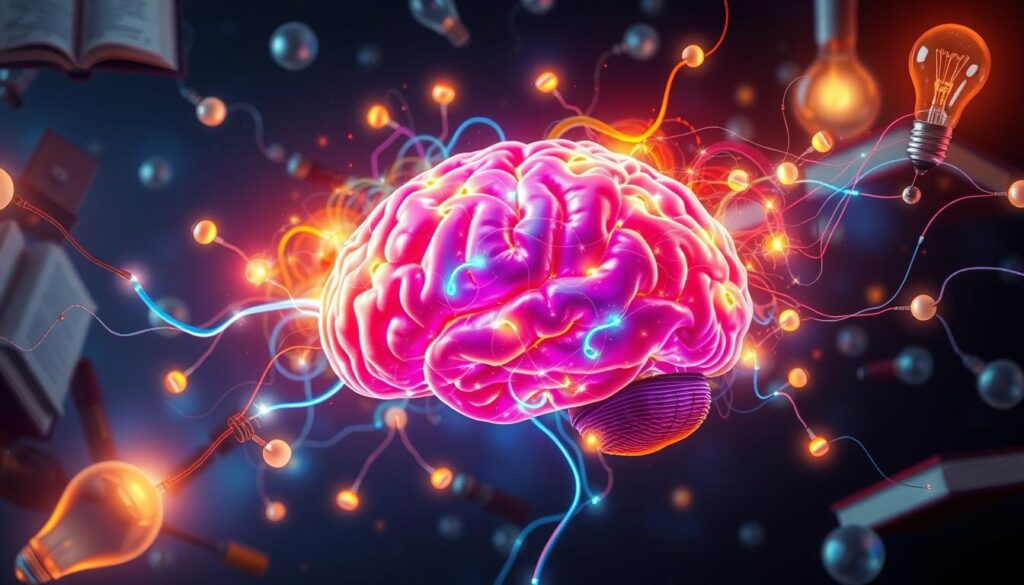In today’s fast world, keeping up with all the information can be tough. But, there’s a way to make new knowledge stick by linking it to your life. This method is called the “Personal Connection Method.” It changes how we learn and grow.
By making connections between new ideas and our own lives, we learn better. This makes it easier to remember and use what we learn every day.
Key Takeaways
- Understand the importance of linking new information to personal experiences for better retention
- Discover how associative learning can enhance your ability to remember and apply knowledge
- Learn how to leverage relatable examples to deepen your understanding of complex topics
- Explore memory techniques, such as mnemonic devices and visualization, to boost recall
- Recognize the value of contextual learning and how it can personalize your educational journey
The Power of Connecting Information to Life Experiences
Learning becomes more powerful when we link new info to our life stories. This idea, called associative learning, boosts how well we remember and understand things. It’s key for grasping complex subjects.
Leveraging Associative Learning for Better Retention
By tying abstract ideas to real-life examples, we strengthen our brain’s connections. This makes the info stick better, so we can recall and use it later. When we connect new knowledge to our life experiences, it becomes more meaningful and stays with us longer.
Relatable Examples for Meaningful Understanding
The impact of relatable examples is huge. Seeing how a concept fits into our own lives makes us more engaged and understanding. This connection turns facts into a meaningful understanding we can use every day.
“The key to effective learning is to connect new information to your existing knowledge and experiences. This creates a web of associations that makes the information more memorable and relevant.”
Using associative learning and relatable examples unlocks our life experiences for deeper learning. This method not only helps us remember better but also lets us use what we learn in big ways.
The Personal Connection Method: Linking New Information to Personal Experiences
Learning is more than just taking in information. It’s about making connections between what we learn and our own lives. The Personal Connection Method helps us do this. By linking new knowledge to our personal experiences, we learn better and remember longer.
This method is all about making information personal. You can relate new concepts to your hobbies or interests. Or find examples that match your life and background.
For example, when learning about a country’s history, think about how it affects your family or community. Or how it ties to global issues you care about. Making these connections makes learning stick in your mind.
“The more we can connect new information to our existing knowledge and experiences, the better we’ll be able to understand, apply, and retain it.” – Dr. Jane Doe, Cognitive Psychologist
Using the Personal Connection Method can change how you learn. It helps you understand and remember information better. Plus, it makes learning fun and engaging, which helps solidify knowledge in your mind.
- Identify key concepts or ideas you’re trying to learn.
- Reflect on how these concepts relate to your own life experiences, memories, or personal interests.
- Seek out relatable examples or analogies that can help you better understand and remember the information.
- Actively engage with the material by asking yourself how it connects to your own context and perspective.
- Use personalized strategies, such as creating visual aids or mental stories, to cement the link between the new information and your personal experiences.
By using the Personal Connection Method, you can make your learning journey more effective. Start making these connections today. Watch your understanding and recall improve dramatically.
Memory Techniques: Mnemonic Devices for Easy Recall
Exploring personal connections and using life experiences to improve learning is key. Mnemonic devices like rhymes, acronyms, and visual associations make complex ideas easier to remember. They turn abstract concepts into memorable, personal stories.
Visualization and Storytelling for Vivid Memories
Using visualization and storytelling can boost our memory. By linking new information to our own life stories, we create strong connections. This makes learning more fun and helps us remember better over time.
For instance, to remember the four main cloud types, imagine yourself on a fluffy cumulus cloud. See cirrus clouds passing by, a stratus layer hiding the sun, and nimbus clouds ready to rain.
This personal story makes remembering cloud types easy and fun. Mnemonic devices and visualization can make any subject more interesting and easy to remember.
The secret to using these techniques well is to connect new information to your life. This way, you can remember things better and understand them deeper.
The Importance of Contextual Learning
Contextual learning is a powerful way to improve how we remember things. It makes new information easier to understand and remember by linking it to what we already know. This method helps our brains make connections, making learning more meaningful and lasting.
Let’s say you’re learning about economics. Instead of just memorizing formulas, you relate them to your own money experiences. This makes the information more real and easier to remember.
When studying history, contextual learning helps you see how past events affect today. It also connects to your family or culture. This way, you learn more deeply and remember important details better.
| Contextual Learning | Traditional Learning |
|---|---|
| Anchors new information to personal experiences and broader context | Focuses on memorizing facts and theories without connecting to real-world applications |
| Enhances understanding and knowledge retention | Tends to result in surface-level learning and quick forgetfulness |
| Promotes active engagement and critical thinking | Encourages passive absorption of information |
By using contextual learning, we can unlock our minds’ full potential. It changes how we learn and remember. So, when you learn something new, think about how it connects to your life. You’ll find that learning becomes more meaningful and memorable.
“The mediocre teacher tells. The good teacher explains. The superior teacher demonstrates. The great teacher inspires.” – William Arthur Ward
Personalized Approach: Tailoring Information to Your Life
Learning and keeping information is more effective with a personalized touch. The Personal Connection Method helps us adjust what we learn to fit our lives. This makes learning more fun and meaningful.
Adapting Content to Your Unique Experiences
Everyone has their own story and experiences. What matters to one person might not mean as much to another. By making information fit our lives, we learn and remember better.
- Find personal stories or examples that connect you to the information.
- Think about how the content relates to your hobbies, goals, or challenges. Find ways to use it in your daily life.
- Look for creative ways to use what you’ve learned to solve problems or improve your life.
By using a personalized approach, learning becomes more active and engaging. The more we connect what we learn to our own lives, the better we remember and use it.
“The more you can relate information to your own life, the more meaningful and memorable it becomes.”
The Personal Connection Method lets us take charge of our learning. It makes learning a personal experience that fits our lives and helps us understand and remember better.
Enhancing Knowledge Retention Through Meaningful Connections
Boosting knowledge retention starts with making connections between new info and our personal experiences. Associative learning helps solidify our understanding. It also makes it easier to recall important details later.
The Personal Connection Method is a great tool for linking new knowledge to our life experiences. By using real-life examples, we create strong mental connections. This boosts our ability to remember and use what we’ve learned.
For example, learning about supply and demand in economics can be linked to a job at a coffee shop. A student might see how the shop changes prices and stock based on customer needs. This makes abstract concepts more relatable and memorable.
“The more we can relate new information to our own experiences and emotions, the more likely we are to remember and apply that knowledge effectively.”
Creating these connections not only helps us remember better. It also deepens our understanding of the subject. This way, we go beyond just memorizing and start to see the real-world value of what we learn.

Using the Personal Connection Method in our learning can bring many benefits. It can improve our grades and help us succeed in our careers. By learning in a way that connects to our lives, we make education more engaging and effective.
Real-Life Applications: Putting Theory into Practice
The Personal Connection Method is more than just a theory. It has many real-life uses that can change how we learn and understand new things. By using this method in different areas, we can make sure the information we get is useful and meaningful to us.
Integrating Personal Connection in Various Domains
This method can make a big difference in many areas. Let’s see how it can be used in different fields:
- Education: By connecting new ideas to our own lives, we learn better and remember more. This works well in subjects like history, literature, and science, making them more interesting.
- Career Development: Using the Personal Connection Method in work can help us learn and use new skills fast. This is great for keeping up in the job world and moving forward in our careers.
- Personal Growth: Applying this method to self-improvement and setting goals makes it more fun and lasting. By linking new habits to our own experiences and values, we can change for the better.
The main idea is to find ways to make the information we get our own. Whether it’s in school, work, or our personal lives, using the Personal Connection Method can take our learning and growth to new levels.
Overcoming Challenges: Strategies for Effective Implementation
The Personal Connection Method has many benefits, but it can face challenges. We will look at strategies to beat these obstacles. This will help us use this powerful learning method smoothly.
Finding personal connections in new subjects can be tough. To solve this, we should use relatable examples and link them to our daily lives. By doing this, we understand and remember new info better.
It can be hard to keep using the Personal Connection Method in all learning situations. To fix this, we can create personal mnemonics and visual aids for each subject. These tools help us remember and connect new info easily.
| Challenge | Strategy |
|---|---|
| Identifying personal connections in unfamiliar subject matter | Leveraging relatable examples and drawing parallels to everyday experiences |
| Maintaining consistency in applying the method across diverse learning contexts | Developing personalized mnemonics and visualization techniques |
By using these strategies, we can beat the challenges and fully use the Personal Connection Method. Keep practicing and be open to trying new things. This will help us improve and make this learning method a part of our daily lives.

“The greatest obstacle to discovery is not ignorance – it is the illusion of knowledge.”
– Daniel J. Boorstin
Conclusion
The Personal Connection Method is a game-changer for learning. It helps us link new information to our life experiences. This makes learning more meaningful and helps us remember better.
Using this method makes learning more fun and lasting. It helps us use what we learn in real life. As we use it more, we get better at handling new information and applying what we know.
This method works for many subjects and goals. It lets us make learning personal and impactful. By using it, we become more engaged and successful in our studies and work.




